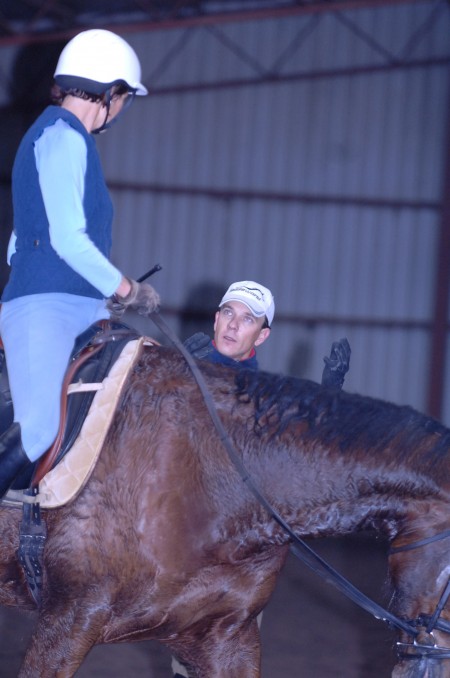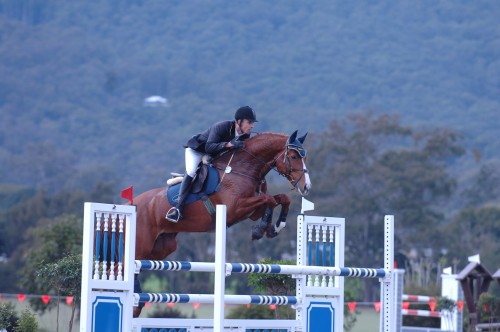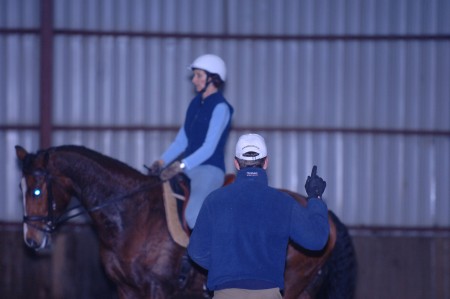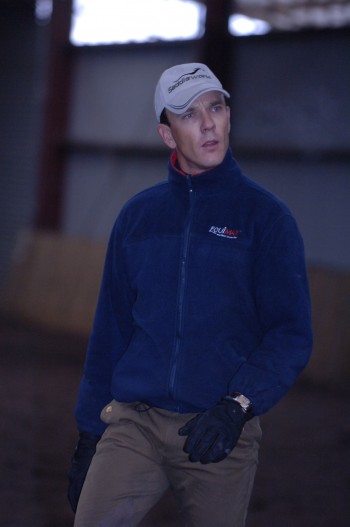Story – Chris Hector & Photos – Roz Neave
Lots of young Australian riders dream about riding and training in Germany, young Queenslander, Shane Davidson DID it – first for six months, then going back for six years to return home a qualified Bereiter, with the added advantage of being fluent in German. Shane returned to Germany with his homebred stallion Catargo last year for training and to compete at the World Young Jumping Horse competition in Lanaken, and then returned home again– but he certainly could have stayed on. There were a number of German training barns clamouring for the Aussie to stay and work for them – but at the end of the day, it was back to the family stud, back to training horses for the Australian jumping and dressage circuits, and an expanding role as a teacher. We caught up with Shane at his Victorian clinic at Silverdene stud…
Watching Shane teach, it is obvious that he spent his time in Germany wisely. His message is straight out of the modern German riding canon – forward into a soft contact, the rider in balance, the horse in balance, and the horse doing the work. Sounds simple, it even looks simple when Shane hops on the horse to demonstrate what he has been talking about, but it looks hard work for some of his students…
Later we shared a coffee, talking about the rider problems that Shane was dealing with…
Watching the riders in your lesson – like so many lessons you see in Australia – they all work too hard. They are at their horses all the time… legs pumping, hands flapping, everything moves except the horse…
“It’s a trap we can all fall into. The way I learnt was by going overseas, starting with some really good riders. They may not be so well known, but they are very good riders, and very good at what they do. Auction riders. People like Bimbo Peilicke and Mani Koetter, they help you with things like that, and it makes the whole picture look better if you can sit there, apply an aid, and know that it is going to be effective, so you are not nagging the horse. Just make it happen without it even looking as if it is happening. Watch any of those top riders, dressage or jumping, and they just seem to sit there and it happens – it’s as though they ‘think’ what the horse should be doing, and the horse responds.”
It seems to get to the stage where it is an unconscious process – one of your students said ‘but I don’t feel I’m doing anything’ and yet her legs were going all the time…
“It’s hard. I think the trap a lot of people fall into, is that they ride on their own. In Europe, riders work together all the time and they are lot more conscious of how they ride, how they sit. They try a lot harder when someone else is there watching them than if they were toddling around at home.”
Over there they are also used to riding properly schooled horses, where you put on a light aid and get the response, whereas over here, riders tend to have to learn to ride while they teach their horse to be ridden…
“That’s true, but the good horses have to start somewhere. If you go over to ride and work in Europe, then at first you do get the young horses, and it is easier if you work with a young horse right from the start, if you break him in. Don’t expect as much from him as you would an experienced school horse, but teach him that if you put your leg on then he has to react. Some horses may take longer to react, some quicker, but why not teach them to go the way you want them to end up going, from day one?”
One thing I think we also have is a major problem with the frame of our horses – even riders at FEI levels, their horses’ heads are going up and down, whereas even the young horses in Europe tend to work right from the start in a lovely frame and with good contact?
“I think in Australia – even with the older horses – we should not concentrate so much on riding the tricks. It’s more important to establish a good foundation, have a good soft even contact from day one – don’t throw the reins at him, and don’t hang onto the reins either. Have him between your legs from the first go, have him on your seat and your weight. Your hand is only really guiding him to where he ought to be, that’s the classical way, from the motor behind to the front, not the other way around.”
“It’s really going back to your foundation and having your one-plus-one established from day one, from his first rides as a three year old – instead of having your horse broken in by a cowboy. When we break in horses at home, we teach them from day one to be round, to go on to the bit, give them the confidence to go to your hand, and to go forward. They may be a little behind the vertical – I guess I am about to upset every dressage judge in the country – but why not establish a contact at first, and then when the horses get stronger and can carry themselves, ask them to put their nose forward a bit. Have the control first so you don’t suddenly surprise the horse when he goes to his first competition. That’s crazy, he goes to the show so now he has to go on the bit – put him on the bit from day one. Have everything nice and settled and harmonious before you even get to a competition.”
“With our Young Horse competitions now, you really need them going forward in a frame, so we can produce good horses later on.”
Where did you get the crazy idea of leaving Australia and going to work in Germany?
“I thought it would be a good thing for our stud. The first time I went there, it was for six months. It was so exciting to see top riders working, to see how they produce horses. The life style over there in Germany was great, and then I came home to see if I could apply what I learnt with our horses.”
Did you speak German when you went to Germany?
“No I didn’t, I learnt it there. The second time I was in Germany for six years, and came back in 2001. Since then I have been working at home, except for the trip to the World Young Jumping Horse Championships with Catargo, last year. That was a great experience to be able to say that you had bred a horse, started him under saddle and then be able to take him over to Belgium to a world title and do well on him, to have riders like Nelson Pessoa and Gerry Schmidt watching him warm up and looking at him hard. It was a great buzz to be there.”
Is it necessary to go back to Europe and get the re-tune?
“I feel as though I am riding better, when I come back from overseas. Everyone falls into habits, and it is great having a network of friends over there that help me. To go over there and be able to ask them questions and they are always so willing to respond – it’s second nature to them, they live and breathe horses. And they can answer your questions easily because they have ridden so many horses and seen so much.”

We get a lot of letters from young Australians who want to go and train in Europe – what advice would you give them?
“You have to be willing to work. My first winter there was minus 15 degrees… which was a bit different from sunny Queensland. You have to be prepared to muck out stables, to wash horses off, to groom – do everything, but at the same time, keep your eyes open.”
How do you get into a stable?
“It’s not so hard these days with the inter-net you can go to their websites and ask if they want help. Or if you know other people who have been there, do your research, and ask. Send a resume and most stables are prepared to take someone on, it’s just a matter of wanting to do it, and wanting to work hard for it.”
Do you have to go to one of the famous stables?
“There are so many good riders there that we never even hear of, because of the wealth of talent in that country, and the tradition of horse breeding and producing horses. There are so many good stables that produce super horses. Last year I went to Hannes Baumgart’s stables, he produced Isabell Werth’s new horse, Warum nicht. There are lots of stables where you can learn.”
But you get the stories – oh, they yell at you, and they make you work so hard, you will be so miserable over there?
“That can happen here in Australia. I’d say to young riders, just give it a go. You might not get to ride every day, you may not be given older horses to ride every day – it’s definitely worthwhile even if you ride the young horses. That’s how I learnt, I started off with the young horses, then progressively got older horses that I could compete at the shows, and just worked from the bottom to the top.”
“I didn’t mind driving tractors if I had to, it’s just a learning curve. Doing things like that helps you when you have to manage your own place, seeing how they run their business. Seeing the business side of it is interesting. It’s not just the attitude – ‘I’m going over to Germany to ride and that’s all I want to do’. Keep your eyes open. Even the way the shows are run, the way their classes are structured…”
Are you a jumping rider who rides good flat or a dressage rider who keeps riding jumping horses?
“I don’t know. People say to me that I have to make up my mind what I want to do, but a very good trainer of riders in Germany – Manfred Koetter – told me, it doesn’t matter what you ride, dressage or jumping, or eventing, there is only ever one proper way to ride…”
With wins in both dressage and jumping young horse classes, it would seem that Shane is riding ‘the proper way’.



